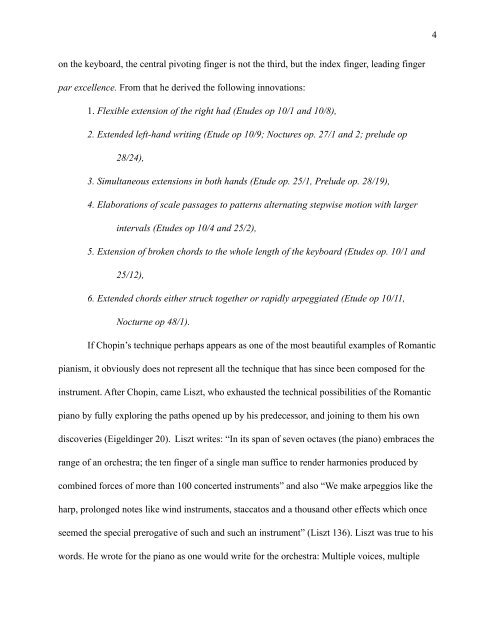Click here for the (pdf) - Michael Kravchuk
Click here for the (pdf) - Michael Kravchuk
Click here for the (pdf) - Michael Kravchuk
You also want an ePaper? Increase the reach of your titles
YUMPU automatically turns print PDFs into web optimized ePapers that Google loves.
on <strong>the</strong> keyboard, <strong>the</strong> central pivoting finger is not <strong>the</strong> third, but <strong>the</strong> index finger, leading finger<br />
par excellence. From that he derived <strong>the</strong> following innovations:<br />
1. Flexible extension of <strong>the</strong> right had (Etudes op 10/1 and 10/8),<br />
2. Extended left-hand writing (Etude op 10/9; Noctures op. 27/1 and 2; prelude op<br />
28/24),<br />
3. Simultaneous extensions in both hands (Etude op. 25/1, Prelude op. 28/19),<br />
4. Elaborations of scale passages to patterns alternating stepwise motion with larger<br />
intervals (Etudes op 10/4 and 25/2),<br />
5. Extension of broken chords to <strong>the</strong> whole length of <strong>the</strong> keyboard (Etudes op. 10/1 and<br />
25/12),<br />
6. Extended chords ei<strong>the</strong>r struck toge<strong>the</strong>r or rapidly arpeggiated (Etude op 10/11,<br />
Nocturne op 48/1).<br />
If Chopin’s technique perhaps appears as one of <strong>the</strong> most beautiful examples of Romantic<br />
pianism, it obviously does not represent all <strong>the</strong> technique that has since been composed <strong>for</strong> <strong>the</strong><br />
instrument. After Chopin, came Liszt, who exhausted <strong>the</strong> technical possibilities of <strong>the</strong> Romantic<br />
piano by fully exploring <strong>the</strong> paths opened up by his predecessor, and joining to <strong>the</strong>m his own<br />
discoveries (Eigeldinger 20). Liszt writes: “In its span of seven octaves (<strong>the</strong> piano) embraces <strong>the</strong><br />
range of an orchestra; <strong>the</strong> ten finger of a single man suffice to render harmonies produced by<br />
combined <strong>for</strong>ces of more than 100 concerted instruments” and also “We make arpeggios like <strong>the</strong><br />
harp, prolonged notes like wind instruments, staccatos and a thousand o<strong>the</strong>r effects which once<br />
seemed <strong>the</strong> special prerogative of such and such an instrument” (Liszt 136). Liszt was true to his<br />
words. He wrote <strong>for</strong> <strong>the</strong> piano as one would write <strong>for</strong> <strong>the</strong> orchestra: Multiple voices, multiple<br />
4


